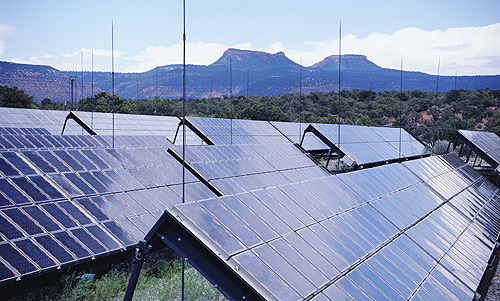Berkeleyan
 Rooftop solar installations have become common additions to residential and commercial buildings, in part because of a widespread belief in their cost-effectiveness. A new Berkeley report casts doubt on that virtue. |
Solar panels 'a loser' in the search for affordable energy
Solar-photovoltaic systems not only cost four times as much money as they 'save,' says Haas School researcher Severin Borenstein, but they're installed in the wrong places
![]()
| 27 February 2008
Despite increasing popular support for solar photovoltaic panels in the United States, their costs far outweigh the benefits they yield, according to a new analysis by Severin Borenstein, a professor at the Haas School of Business and director of the UC Energy Institute.
Solar photovoltaic (PV), says Borenstein, "is a very exciting technology, but the current technology is not economic. We are throwing money away by installing the current solar PV technology, which is a loser."
In his January working paper "The Market Value and Cost of Solar Photovoltaic Electricity Production," Borenstein also found that the cost/benefit ratio for solar panels remains negative even after considering that the panels reduce greenhouse gases.
The bottom line, he argues, is that solar PV panels are not ready for widespread installation. Instead, he favors more state and federal funding for research and development.
"We need a major scientific breakthrough, and we won't get it by putting panels up on houses," says Borenstein. "It is going to come in the labs."
Using actual wholesale electricity prices and simulated data to calculate the extent to which timing enhances the value of solar photovoltaic panels, Borenstein found that the favorable timing of solar PV production increases its value by up to 20 percent. (Solar panels generate more power on summer afternoons, when the value of electricity is higher for most U.S. electricity systems.) However, he notes, the premium value of solar photovoltaics could be from 30 to 50 percent higher if U.S. systems were run with less capacity and prices were allowed to rise as demand increases at different times of the day.
Borenstein, who has long advocated such variable-time pricing, says that U.S. systems typically operate with excess capacity and that consumers pay the same price for electricity at all times of the day: "Basically, the benefits of solar PV are undermined by the way most grids are run today."
He notes that utilities are slowly moving toward operating with less excess capacity and with time-varying pricing for residential customers, and that these changes are expected to be in place for customers to choose on a voluntary basis in California by 2012. "When that happens, the value of solar will go up," Borenstein says.
His analysis deconstructs the argument that solar panels produce power at the location of the end-user and therefore can reduce the costs of transmission- and distribution-infrastructure investments. Examining 26,522 solar PV systems in California, Borenstein found they are not concentrated in locations where they would reduce transmission congestion and reduce the need for investment in transmission infrastructure.
Taking the analysis a step further, he calculated the discounted net-present value (that is, the value of a dollar in the future compared to its value now) of power produced by a 10-kilowatt solar photovoltaic system and then compared that to the cost of installing and operating such a system over its lifetime. He found the cost for an installation ranges from nearly $86,000 to $91,000, while the value of the power produced ranges from $19,000 to $51,000.
Under the most extreme assumptions (a 5 percent annual increase in electricity costs and 1 percent real-interest rate), the cost of solar PV is about 80 percent greater than the value of the electricity it will produce, Borenstein found. Under more likely scenarios for interest rates and electricity-cost increases, the cost of a solar PV installation today is three to four times greater than the benefits of the electricity it will produce, he says.
"It is worth noting," he wrote, "that even without further technological progress in energy generation from wind, geothermal, biomass, and central-station solar thermal, with a 5 percent annual increase in the real cost of electricity, all of these technologies would be economic (without subsidies or recognition of environmental externalities from fossil fuels) well before the 25-year life of solar panels was over."
Borenstein's paper, which has already attracted substantial comment - positive and negative - from energy analysts and boosters of solar power, is online at www.ucei.berkeley.edu/PDF/csemwp176.pdf.

